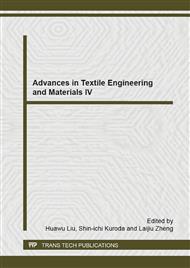p.46
p.52
p.57
p.62
p.66
p.72
p.77
p.81
p.85
Study on Undegummed Pineapple Leaf Fibers’ Moisture Absorptions
Abstract:
Programmable constant-temperature/humidity test chamber owned by Natural Fiber Laboratory, Institute of Agricultural Machinery, Chinese Academy of Tropical Agricultural Sciences, is adopted to analyze undegummed pineapple fibers’ moisture absorptions. Study and analysis on moisture absorptions, moisture-absorption isothermsand moisture-absorption isohumes with constant temperature and inconstant humidities are carried out and the results show that fibers’moisture absorptions present roughly a regularity of such three stages as 0~20%, 20~80% and 80~100% (RH). In low-moisture stage, moisture absorption rates are higher; in middle-moisture stage, they level off; in high- moisture stage, moisture absorption rates are the highest. Fibers’moisture absorption amounts decrease along with temperature rise; but under the condition of high humidity, they increase along with temperature rise and also increase along with humidity rise. Study on undegummed pineapple fibers’moisture absorptions may provide theoretical basis for undegummed pineapple fiber preservation and textile processing in some special industries.
Info:
Periodical:
Pages:
66-71
Citation:
Online since:
October 2014
Authors:
Price:
Сopyright:
© 2014 Trans Tech Publications Ltd. All Rights Reserved
Share:
Citation:


